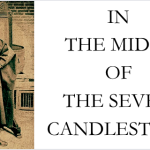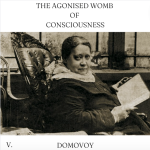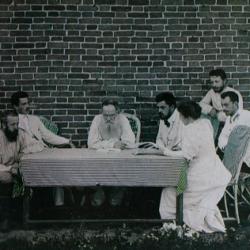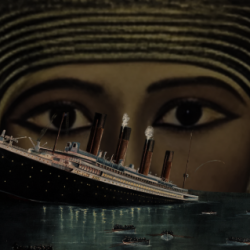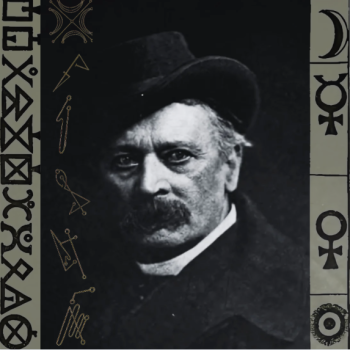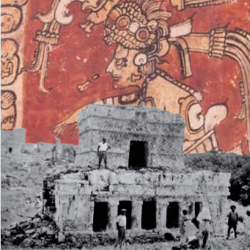DENIZEN OF ETERNITY
IV.
⸻
“Now that we have the Theosophical Publishing Society, I want to print your stories. I want to make a volume of novels under which Russian names will be sold,” Blavatsky told her sister, Vera Petrovna. She arrived in London from Russia a few days earlier with her daughter, Verochka, (Blavatsky’s niece.)[1] Joining them was Charley, whom, as Blavatsky noticed, was one of the few people who could cheer up her mourning niece. “We have our own office and library at 7 Duke Street,” Blavatsky continued. “The Countess Wachtmeister and Mabel Collins alternate turns there. They sit three times a week, and welcome those who wish to learn about Theosophy. As for Verochka. It will be good, as you say, for her to get some impressions. She can write from here for Russian magazines or newspapers.”[2] Blavatsky, passing Charley’s chair en route to the parlor, stopped to stroke his hair. “I know you use a tallow candle-end to keep it smooth,” said Blavatsky.[3]
“I tell you, I do not!” said Charley with a lilted laugh.
“Yes, you do,” she said as she walked into the other room.
Charley smiled and shook his head. He stole another glance at Verochka. Her shade of red could not be attributed to the English sun. Many saw in her a marked resemblance to her famous aunt, but whereas Blavatsky “boasted of being plain looking,” Verochka was very beautiful girl, who did not shy away from her femininity. She was tall and slender, with golden-red hair, soft blue eyes, and a chiseled profile. The oldest of three sisters, Verochka, was born in Tiflis, in the Province of Georgia, on December 23, 1864.[4] Her childhood was spent in the peaks of the Caucasus Mountains, where the descendants of the Chaldeans still cherished the memories of the “Golden Fleece,” and where mountaineers still beheld “Prometheus bound upon the misty summit of the mountains.” Like all the women in her family, Verochka was a talented writer, a skill cultivated since childhood.
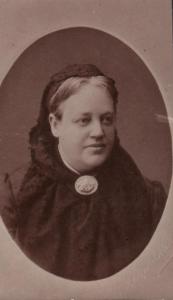
Vera Petrovna Zhelihovsky.
Her mother, Vera Petrovna, was the author of children’s books. Her current project, Rosanchik, was a fairytale about a little girl who saves her brother from an uncertain fate. It was, no doubt, a means by which to process the recent death of Valya. Twice widowed, Vera Petrovna’s first husband was Nikolai Nikolaevich Yakhontov (brother of Russian poet, Alexander Yakhontov,) a landowner from Pskov. Together they had two boys, Fyodor and Rostislav. Yakhontov caught a fatal cold and died in February 1858. In 1862 Vera Petrovna married the director of a classical gymnasium, Vladimir Zhelihovsky, and had three daughters, Vera (“Verochka,”) Nadezhda, Elena, and one son, Valerian (“Valya.”) When Zhelikhovsky died in the spring of 1881, Vera Petrovna and the children moved to Odessa, where they lived until 1885. To support the family, she contributed articles to Russian newspapers and magazines, many of them being about Blavatsky and the Theosophical Society. They later moved to St. Petersburg, and most recently, after the death Valya, to Moscow.
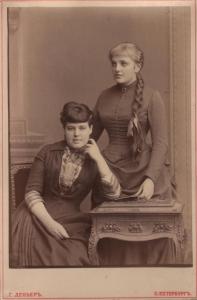
Nadezhda & Elena Zhelihovsky.
Vera Petrovna had pinned her hopes for financial support of the family on the twenty-two-year-old son, Valya. He had nearly finished his courses at the Institute of Railway Engineers when he died from tuberculosis two months earlier at the Londonskaya Hotel, Odessa.[5] Verochka, being very close to Valya, was devastated. When Blavatsky learned of Verochka’s state of mind after Valya’s death, she covered all the expenses to bring her sister and niece to London so they might recalibrate.[6]
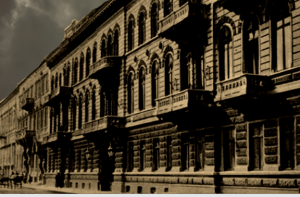
Londonskaya Hotel, Odessa.
“My dear,” Blavatsky said to Charley when she returned to the room, “would you mind escorting my niece on a walk before Hartmann arrives?”
Vera Petrovna gave Blavatsky a “mother’s look.”
“Of course, we will be watching from the window,” Blavatsky added.
“Why, uhh, yes, of course, I mean, that is, if Verochka would like—”
“Da,” said Verochka, “Poydem.”
“‘Let’s go.’ Am I correct?”
“Molodets!” said Vera Petrovna. “He is a quick learner.”
“It’s monotonous here,” said Verochka. “Mom and I wake up early every day. The call for breakfast is at 8 a.m., but we don’t go. We drink tea at 10 a.m., after which mom immediately sets off to wander around London alone. I almost never go out. I’m tired of everything. My melancholy is simply absurd.”
Verochka’s halo of grief captivated Charley. Nobody seemed more worthy of all his attention, care, and love.
“The English hate the Russians, but I don’t care,” continued Verochka. “I hardly go downstairs when Aunt Lelya has guests anyway. I go to her when she is alone, or I go to the garden. Children are always playing in it.” Verochka pointed to the small garden behind the house. “I sit there under that huge maple tree.”
A slender, well-dressed woman of forty was seen across the garden approaching a hansom cab.
“Is that Mabel Collins?” Charley asked.
“Who is Mabel Collins?” Verochka asked.
“She channeled Light On The Path.”
~
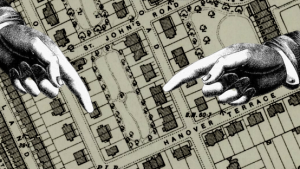
(Left Finger) 34 Clarendon Road. (Right Finger) 17 Lansdowne Road.
Mabel Collins, the co-editor of Lucifer, lived at 34 Clarendon Road, just across the garden which it shared with the house on 17 Lansdowne Road. The houses were so close, in fact, that Blavatsky and Collins had devised a system of signaling to each other across the garden whenever they wished to see one another. Besides her output of novels, and Theosophical literature, Collins wrote a fashion column for Edmund Yates’ periodical, The World. It was not uncommon to see her dashing about London in a hansom cab in pursuit of latest fashion news.[7]
She was born Minna Mabel Collins in 1851 at St Peters Port, Guernsey, and though never formally educated, proved a skilled writer since childhood. In 1871 Mabel married Keningale Robert Cook, a stockbroker, writer, and former editor of The Dublin University Magazine. Both Mabel and Keningale contributed numerous articles to magazines, mostly on topics concerning education, fashion, and women in the arts. The couple lived for some time in a house in the Adelphi the looked upon the Thames. Mabel found married life tedious, and feared that “her brain was atrophying,” from boredom. That would soon change. In 1878 an obelisk brought from Egypt known as Cleopatra’s Needle, and installed on the bank of the Thames just outside her window. From the very first moment she saw the Needle, she was “aware of a face in it,” that “was not visible to anyone else.” It was the face of an Egyptian, “full of power and will, and intensely alive.” The face was the same width as the Needle, which impressed upon her mind that it was an “imprisoned being” of some kind, that was “too large for the space in which it was confined.” Mabel soon noticed that “strange-looking men” began visiting the obelisk—men who were “dressed in a peculiar garb.” One day a group of such men, a procession of white-robed priests entered her house through the front door and walked up the stairs into her room and encircled her. This event would be repeated regularly, and each time they visited, Mabel would enter a trance state of psychography, or automatic-writing, whereby a different consciousness took control of her hands to produce “sheet after sheet” of composition. After several days, the first seven chapters of what would become The Idyll of the White Lotus were complete.
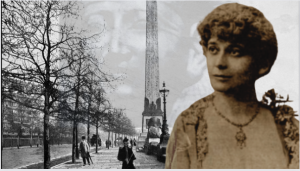
Mabel Collins & Cleopatra’s Needle.[8]
In 1885 Mabel produced another psychographical work titled Light On The Path, which was published in the New England Spiritualist journal, The Banner of Light. While writing it, Mabel described being in a “wide-awake state,” and was transported to “some large library,” which she called the “Hall of Learning.” G.B. Finch, President of the London Lodge, then published Light on the Path as a brochure, and distributed it among the members, “to their great pleasure and satisfaction.” Mabel thereafter became a “devoted disciple” of Blavatsky. It was Blavatsky who told Mabel that the author whom she “channeled” was none other than Hilarion, a Cyprian Adept who was affiliated with the White Lodge (a mysterious council of perfected beings known as Masters, or Mahatmas, who helped guide humanity toward a path of light.)
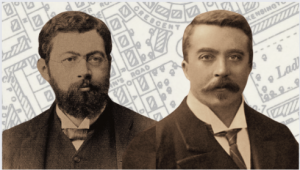
Arch Keightley & Bert Keightley.
Keningdale Cook died in 1886, and left Mabel enough money to live comfortably for some time. In 1887 Blavatsky moved to London from Ostend, Belgium, with the assistance of Dr. Archibald “Arch” Keightley and his uncle (though junior in age) Bertram “Bert” Keightley. For the first few months of her stay, she lived with Mabel in her home in Upper Norwood. Once installed in London, Blavatsky tasked Mabel and the Keightleys with editing The Secret Doctrine. It was during this period when Charley first met Blavatsky. The Blavatsky Lodge was soon established (as an alternative to the above mentioned London Lodge,) the members of which provided the start-up capital for the Theosophical Publishing Society. Blavatsky, who long had difficulty getting her views expressed in The Theosophist (the India based magazine which she started Olcott,) launched her own magazine, Lucifer.[9]

Lucifer (Wiki.)
By September 1887 newly living arrangements were made; Mabel moved to Clarendon Road, and Blavatsky, the Countess Wachtmeister, and coterie of Theosophists established themselves at 17 Lansdowne Road, sharing a space for some time with the Theosophist, Platon Drakoules.[10] The founder and editor Greece’s first Socialist magazine, Arden, Drakoules shared close ties with the Fabians.[11] At the time that Blavatsky arrived, Drakoules was corresponding with Spiritualist magazines in support of the theory of “Inter-Planetary Soul-Communion.” Curiously, Drakoules wrote under the name “Plato E. Draculi,” which, as The Telegraph noted in the 1880s, “draculi” were a ghoulish class of supernatural “fiends” that plagued the people in the Carpathian Mountains of Romania.[12]
~
“What is it about?” Verochka asked.
“Light On The Path?”
“Yes.”
“It is about the enlightenment of the Soul,” said Charley. “The development of the higher part of our nature. Developments that cannot take place until a certain battle has been fought and won. The combatants are the higher nature, or Soul on the one side; and the lower nature or egotism on the other. The higher nature includes the intellectual, Spiritual, and aesthetical powers: that is to say, the powers which deal with the perception of truth, goodness, and beauty. Egotism, on the other hand, raises a selfish claim for a monopoly of all good things, all pleasures, all enjoyments.”[13]
“Do you really believe all of this?”
Charley was quiet for a moment. When speaking of matters spiritual, he possessed a rare self-poise for a boy of his age. His carefully modulated voice, almost quiet, would have suited him well had he continued his path to priesthood.[14]
“Have you ever stood on the shore and watched the incoming tide?” said Charley. “First a tiny ripple advances a few inches over the yellow sand, then retreats, as if frightened by its daring, into the deeper sea. A second wave advances further than the first, and in its turn retreats, to be followed again by another, and so wave follows wave, each gathering greater strength and volume until the sea sweeps in towards the land and covers all the broad stretch of sand with water. It is the same with the tide of knowledge and truth. So was it with Christianity. The first wave began in the Sermon on the Mount, and flowed on until it reached its limit on Calvary. It was adorned with many strange wonders and marvelous sights. It was surrounded with mystery and miracle, and its founder was credited with unheard of powers. Multitudes were gathered together, and all men went after him. What was the end of all this turmoil and excitement? They all forsook him and fled. The wave had reached its limit and flowed back into the sea from whence it came. The Theosophical Movement is the returning tide of the Spirit and Truth which has ebbed from the world’s religions, but it must be remembered that it is we ourselves who must make the future, if it is really to exist at all. Looking within ourselves, we find two powers ever at war, the flesh lusting against the Spirit and the Spirit against the flesh. We find two opposing centers from which all the forces of our life proceed. The one center is the self, the other is the soul. Learning of our own nature, we perceive that by attaining to its perfection we shall fill our true place in Humanity and so realise the ideal of Universal Brotherhood. By gaining knowledge ourselves we become able to teach others to realise this ideal, and thus may we lighten the sin and suffering of the world.”[15]
“You remind me of Valya—in some ways.”
“In what ways?”
“I remember when Valya’s great mind was awakened—he was about 14 or 15,” said Verochka. “It was awakened without reading, without education, without effort. His mere presence—his spirit—uplifted everyone he met. He could inspire strangers without even speaking.” Verochka’s voice grew dim. “Valya’s pure and lofty soul, finding no reason to remain on earth, decided to leave. He fulfilled his purpose in this life.”
Charley was anchored to her words. Women, and Verochka was no exception, seemed to have an “inborn and incommunicable excellence in matters as spirituality and idealism,” Charley thought, “and the divining of that finer world which is nonetheless real because it is invisible.”[16]
“I had not seen my aunt for twenty years previous to 1886, so I went to Ostend to pay her a visit,” Verochka continued, changing the subject. “It was morning, and she had not yet risen. Charley, I cannot tell the feeling with which I approached the bed where lay that gigantic shapeless something with a head—a cross between an elephant’s and a lion’s—taking up the whole of the pillow! I ate breakfast with her then—and every morning after—as soon as she had done her smoking. I remember one morning as she smoked, and I waited for breakfast, we had a discussion about an error of grammar in her writings. She handed me many pages of The Secret Doctrine, which I corrected.” Verochka, sensing that Charley wanted to say something in Blavatsky’s defense, added a quick clarification. “You know when you are too near a large body, you see little of it?”[17]
“Yes,” nodded Charley. “The first and earliest impression I received from Blavatsky, in fact, was the feeling of the power and largeness of her individuality. It was as though I were in the presence of one of the primal forces of Nature. Like being in a room with a tremendously active volcano.”[18]
“Well,” Verochka continued, “I am sure that if any of her English admirers knew her as I do in my daily intercourse with her, they would say, ‘That woman never wrote the Secret Doctrine.’ Many people insist that Isis Unveiled, and aunt Lelya’s other books, are the result of her reading, or wholesale appropriation, of the text of other books. When I lived with her, she had no library to speak of. She had only some French novels—for which she has an inordinate taste—and a few Russian magazines. None of these could have helped her in any way. I do not think she is so intellectual as many hold.”[19]
“What’s ‘not intellectual’ about French novels?” said Charley with a wink. “There’s great wisdom in Daudet’s Tartarin of Tarascon,” he said, quoting a line. “‘Imagination, Oh magic power!’”[20]
“I believe she possesses a wonderful power—different from and beyond intellect,” said Verochka. “Through it she writes her great works, not understanding many of the things she writes in them.”[21]
“I have often felt these startling, unexpected glimpses into profundity in Madame Blavatsky’s presence,” said Charley. “When the richness and sympathy of her character almost tempts one to believe her nothing more than a fascinating personality. One is lulled by her sympathetic personality, and tranquilized by the feeling of balanced power, so that her quality of inner light remains unnoted, until some sudden turn of thought or change of feeling opened the eyes, and one recognized the presence of a denizen of eternity.”
“Aunt Lelya does have one talent that I never hear spoken of,” Verochka said, “and which makes her many enemies.”
“What’s that?”
“She is a good caricaturist,” said Verochka. “With just a few touches of her pencil, she can turn out a picture so like, yet so unlike, her subject, that she is hated for evermore by the victim.”[22]
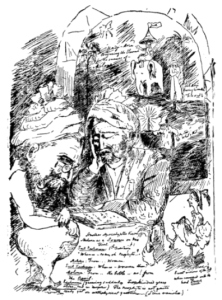
“H.P.B. As Cartoonist —About 1877.”[23]
“Speaking of art and beauty,” said Charley, “what did you think of the ‘Illuminated Garden Fête’ at the Crystal Palace yesterday? I’ve heard the Grand Fairy Ballet’s performance of A Midsummer Night’s Dream is quite the spectacle.”[24]
“The Crystal Palace is an amazing place, but I can’t describe it,” said Verochka. “Mom and aunt Lelya were constantly scolding each other like little children. Aunt Lelya gave my mom £5 for a bag, and told her—in the most quarrelsome tone: ‘Well, I saw you looking. I know you! Buy it and say that all these gifts are for you, and then the children will think “Aunt Lelya is such a pig!“” Then my mom said: ‘Shut up, you old fool! They will still say that! And then they will say that I am a pig!’ The gentlemen present at the time were surprised, and still more confused when they turned around to find aunt Lelya and mom hugging and kissing, and saying ‘I love your, soul‘ and ‘You are a good person, if not for such a throat.‘ They’re so…what is the word…they’re so morbid!” [25]
The thought of Blavatsky acting as a “quarrelsome” sister made Charley laugh. He thought of his own sisters, Georgie, Ada and Ina. “My youngest sister, Ina,” said Charley, “has a habit of waking me up in the morning. ‘Charley, come play with me!’”
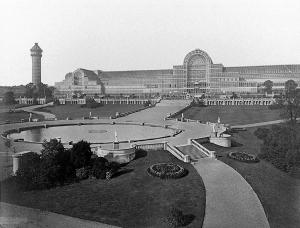
The Crystal Palace.
“The other day, during that thunderstorm, aunt Lelya was very afraid, but I couldn’t help but laugh. She was in such despair because mom was not at home. Countess Wachtmeister ran in full gallop to give her medicine. The Countess tried to reassure aunt Lelya. ‘She will be fine. I travel alone when I am in new cities all the time,’ she said. Aunt Lelya screamed so hard! ‘So you and my sister!’ Oh, Charley, I was so embarrassed. The next day mom and I went with Father Smirnov to an exhibition of paintings. (Hermann Schmiechen’s portrait of Blavatsky was on display at the exhibition of the Nineteenth Century Art Society.)[26] We were already out the door when aunt Lelya called us back, and said in the most touching voice: ‘Dear ladies, if there is hail, for God’s sake, don’t go.’” [27]
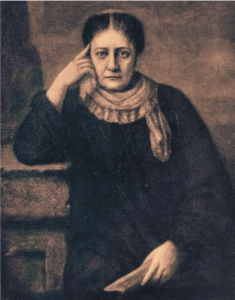
Schmiechen’s Portrait of Blavatsky.
~
While Charley and Verochka were strolling in the garden, Blavatsky and Vera Petrovna were discussing the strange phenomena which occurred after Valya’s death.
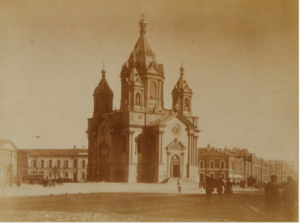
[“Cathedral of the Annunciation, St Petersburg c. 1890.” c/o The Royal Collections Trust.]
“We fasted with Valya in the Horse Guards Church the day after our arrival in St. Petersburg,” said Vera Petrovna. “We held the memorial service there, too, on the 20th day of panikhidi.”[28]
Panikhida, the Service of the Dead in the Russian Orthodox Church, traced its origins to the Desert Fathers. Evening matins and mass were performed every day for forty days after the death (for those whom circumstances permitted.) It was believed that the soul lingered on earth (and given a tour of Hell) before ultimately going to heaven (hopefully,) a process which was facilitated by prayerful intercession of clergy and loved ones.[29] Special requiems were sung on the ninth, twentieth, and fortieth days, over the grave of the deceased, during which time priests were generally entertained as on the day of the funeral, and alms were distributed to beggars.[30]
“The night before leaving, I visited Valya’s grave. I heard his voice, Lelya. He told me: ‘Do not think that I am here in the grave. I came with you from Odessa to Petersburg, and I will come with you to Moscow.’ That same night, some ladies were crying over Valya’s death, when he suddenly appeared. With the most cheerful face, he bowed and said: ‘Hello.’ A few days after that incident, I had a vivid dream. I saw Valya standing over his grave. I called out to him, and held him, and asked him to stay with us. He smiled, shook his head, and said: ‘If only you knew! If you only knew!‘ He then pointed at himself in his coffin. There was some old Slavonic inscriptions written on the casket. I remember being imbued with delight upon reading it. I know he was standing next to me, and happy. He kept repeating: ‘This is the point! This is the whole point!‘ When I awoke, I forgot what the inscription said! All that remained was a sense of awe.”[31]
~
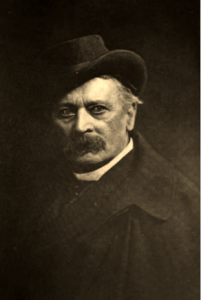
Dr. Franz Hartmann.
Later that evening the Charley, Blavatsky, Verochka, and Vera Petrovna sat in the parlor with the Theosophists Franz Hartmann and Karl Kellner. Hartmann, a German-American, was staying a few days in London on his way to the Bayreuther Festspiele, an annual celebration of Wagner’s music held in the Bavarian town of Bayreuth.[32]
He was accompanied by Kellner, of the Kellner-Partington Paper Pulp Company; an inventor, occultist, and one of the wealthiest industrialists of the Habsburg Monarch. He joined the Theosophical Society a year earlier (as well as an esoteric order known as the Hermetic Brotherhood of Light.)[33]
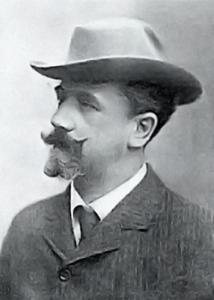
Karl Kellner.
Hartmann was recently in Philadelphia where he visited the inventor John Keely, a man who claimed to have discovered a powerful new source of energy called the “etheric force,” produced by vibrating the “interatomic ether” in water and air. This formed most of the talk that night.
“The law of periodicity has long ago been known to exist in the vibrations producing light and sound,” said Hartmann. “It has been recognized in chemistry by experiments tending to prove that all so-called simple elements are only various states of vibration of one primordial element, manifesting itself in seven principal modes of action, each of which may be subdivided into seven again. The difference which exists between so-called single substances appears, therefore, to be no difference of substance or matter, but only a difference of the function of matter in the ratio of its atomic vibration.”[34]
Verochka leaned toward Charley and whispered. “He’s a nice old man,” she said. “The other day he gave me flowers and asked for my portrait.”[35]
“I have taken great interest in him ever since I first heard of him in 1882,” said Kellner. “As gaslight has driven away, in part, the smoky petroleum lamp, and is about to be displaced by electricity, which in the course of time may be supplanted by magnetism, and as the power of steam has caused muscular labour to disappear to a certain extent, and will itself give way before the new vibratory force of Keely, likewise the orthodox medical quackery that now prevails will be dethroned by the employment of the finer forces of nature, such as light, electricity, and magnetism.”[36]
“This is the Prima Materia, well known to the Rosicrucians,” said Hartmann. “It is the same as substance that later scientists referred to as the ‘Cosmic Aether,’ and what the ancient sages called ‘Akasha.’ Schopenhauer called this force ‘the will of perpetual motion.’ As Madame wrote in Isis Unveiled, Akasha is a Sanskrit word, colloquially meaning heaven; but its scientific significance embraces complex ideas about the principles of being, about the soul and spirit of man, about the light, strength and will of the great principle—the soul of the universe—anima mundi. The time is approaching when all who have sought to defame Keely, all who have stabbed him with unmerited accusations, all who have denounced him as ‘a bogus inventor,’ ‘a fraud,’ ‘an impostor,’ ‘a charlatan,’ ‘a modern Cagliostro,’ will be forced to acknowledge that he has done a giant’s work for true science, even though he should not live to attain commercial success. But history will not forget that, in the nineteenth century, the story of Prometheus has been repeated, and that the greatest mind of the age, seeking to scale the heavens to bring down the light of truth for mankind, met with Prometheus’s reward.”
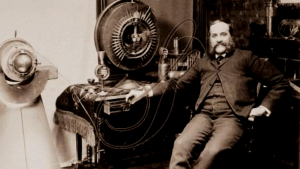
John Ernst Worrell Keely.
“Why!” said Blavatsky with a mysterious smile. “It is sometimes useful to show arrogant humanity that all its knowledge and all the wisdom of a damned egg cannot be compared with that ocean of wisdom and almost limitless power that it could have if it had not been mired in self-interest, selfishness and all sorts of meanness.”[37]
“But it’s not generous to make those who selflessly devoted themselves to science, like Keely, suffer,” said Vera Petrovna. “The people slander him—call him a charlatan, a deceiver, and a madman.”
“So, what of it,” said Blavatsky. “He is not the first, and he will not be the last, to die in the waves of worldly stupidity. He will be rewarded in a future incarnation. Then, perhaps, the time will come to bless the world with the fruits of his discoveries, for which, I am sure, he has tried to do in many lives before.”
“Do you really think the poor fellow has lived in other centuries in this way?”
“I’m quite convinced,” said Blavatsky. “To achieve such results, one must be born gifted…and such gifts are not given away for free. Only one who has reached great occult knowledge during previous incarnations could be born with abilities such as Keely possesses! After all, from a boyish age he began almost without any scientific knowledge, and all his inventions, according to his own consciousness, were given to him by inspiration. He perfected his inventions by ‘intuition’ which he himself claims does not fully understand. It is not ‘intuition,’ rather it is the remembrance of knowledge accumulated from previous existence. The Masters would never allow people, while in their present imperfect state, to possess such terrible forces of nature.”
“Do you know the essence of this power?” asked Vera Petrovna.
“These ‘great scientists’ are just now suspecting the existence of a 4th dimension,” said Blavatsky, “while occultists have been aware of the 4th, 5th, 6th, and even 7th for a long time.”
“But if they are known to all occultists, as you say, then each one of you hold the fate of the world in your hands,” said Vera Petrovna. “You can turn half the world into powder at any given moment.”
“No, we can’t!” Blavatsky replied with a laugh. “We can have theoretical information, but in practice, especially with malicious intent, the Masters will not permit us to apply it…just like they do not allow Keely to popularize their secrets. Keely can master them, and even get practical results from them, because he will not apply them to evil—but to others who might misuse them, Keely will not be able to pass them on. The discoveries of Keely are valid only in his hands. All this means is that yeast is fermenting everywhere,” said Blavatsky, “that the time has come for a new harvest, and the ripening of new fruits. Forces are awakening, incomparably more powerful than earthly levers and material concepts. The spirit has awakened in the mother and enslaves her! The hour of the fifth cycle is near—the entry of the renewed humanity into a new phase. Wherever you look! There are curiosities everywhere! Strange people with exceptional concepts! Some manifestations, phenomena…”[38]
“Yes,” interrupted Vera Petrovna. “But only here in this environment—not in the rest of the world—you can forget about miracles in Petersburg.”[39]
← →
THE AGONISED WOMB OF CONSCIOUSNESS SECTIONS:
INTRO: CHARLEY.
I. WITCH TALES.
II. CARELESS WHENCE COMES YOUR GOLD.
III. THE TIMES ARE CHANGED.
IV. DENIZEN OF ETERNITY.
V. DOMOVOY.
VI. WITH LOW AND NEVER LIFTED HEAD.
VII. IMPERIAL GOTHIC.
VIII. THE SERVANT OF THE QUEEN.
IX. THE DWELLER ON THE THRESHOLD.
X. INDO-GOTHIC YOGA.
XI. INTENDED FROM ABOVE.
XII. THE SÉANCE ON CHEYNE ROW.
XIII. EVEN IN NEW ROOMS.
XIV. RUSSIA’S LEGENDARY LORE.
[APPENDICES]
SOURCES:
[1] They arrived in London on July 6, 1888; Vera Zhelihovskaya to N.V. and E.V. Zhelihovskaya. August 15, 1888 [j.] London, England.
[2] Blavatsky, H. P. “Fragment of a letter from H. P. Blavatsky to V. P. Zhelihovskaya. June 1888.” [Bakhmut Roerich Society.]
[3] Johnston, Charles. “H.P.B.” The Theosophical Quarterly. Vol. XXIX. No. 1. (July 1931): 12-14.
[4] National Archives and Records Administration (NARA); Washington D.C.; Roll #: 140; Volume #: Roll 0140 – Certificates: 55072-55971, 15 June 1911-23 June 1911.
[5] Bogdanovich, Olga. Blavatsky And Odessa. Odessa House Museum. Odessa, Ukraine. (2006): Chapter IV.
[6] Blavatsky, H.P. “Letters Of H.P. Blavatsky: Pt. XII.” The Path. Vol. X, No. 8 (November 1895): 235-240.
[7] Harris, Melvin. The True Face Of Jack The Ripper. Michael O’Mara Books Limited. London, England. (1994): 47; Farnell, Kim. Mystical Vampire: The Life and Works of Mabel Collins. Mandrake. Oxford, England. (2005): 60-80.
[8] Photo of Mabel Collins from: Collins, Mabel. The Confessions Of A Woman. John W. Lowell Company. New York, New York. (1890.)
[9] M.C. “Some Psychic Experiences.” Broad Views. Vol. I, No. 5 (May 1904): 432-440; Keightley, Archibald. “Reminiscences of H.P. Blavatsky.” The Theosophical Quarterly. Vol. VIII, No. 2 (October 1910): 109-122; De Steiger. Isabelle. Memorabilia: Reminiscences Of A Woman Artist And Writer. Rider & Co. London, England. (1927): 241-251; Khandalavala, N. D. “Madame H.P. Blavatsky as I Knew Her.” The Theosophist. Vol. L, No. 9. (June 1929): 213-222; Lane, A.T. Biographical Dictionary of European Labor Leaders, Volume I. Greenwood Publishing Group. Westport, Connecticut. (1995): 277.
[10] Theosophical Society General Membership Register, 1875-1942 at http://tsmembers.org/. See book 1, entry 2994. (website file: 1B:1885-1890) Plato E. Draculi. Corfu. (8/31/1884); Draculi, Plato E. “Inter-Planetary Soul-Communion.” Light. Vol. VII, No. 361. (December 3, 1887): 569.
[11] “The Cause In Greece.” Justice. (London, England) November 16, 1889.
[12] “The Superstitions of Roumania.” The Spiritualist. (London, England) October 21, 1881; Romana, Umbra. “The Truth About Ghosts.” The Daily Telegraph. (London, England) October 11, 1881.
[13] Johnston, Charles. “Light On The Path.” The Path. Vol. I, No. 11 (February 1887): 335-339.
[14] “Even-Song A Greenacre.” The Sun-Journal. (Lewiston, Maine) August 31, 1901.
[15] Johnston, Charles. “The Second Wave.” The Theosophist. Vol. VIII, No. 87 (December 1886): 129-132.
[16] Johnston, Charles. “A College Of Ideals: An Impression Of Bryn Mawr.” Harper’s Weekly. Vol LIII, No. 2746. (August 7, 1909): 16-17.
[17] “Mme. Blavatsky.” The New York Tribune. (New York, New York) May 15, 1898.
[18] Johnston, Charles. “A Memory Of Madame Blavatsky.” Lucifer. Vol. VIII, No. 46 (June 15, 1891): 287-289.
[19] “Mme. Blavatsky.” The New York Tribune. (New York, New York) May 15, 1898.
[20] Daudet, Alphonse. Tartarin of Tarascon. Little, Brown, & Company. Boston, Massachusetts. (1900): 196.
[21] “Mme. Blavatsky.” The New York Tribune. (New York, New York) May 15, 1898.
[22] “Mme. Blavatsky.” The New York Tribune. (New York, New York) May 15, 1898.
[23] “H.P.B. As Cartoonist —About 1877.” The Theosophist. Vol. LII, No. 11 (August 1931): 608.
[24] “Advertisement: Crystal Palace.” The South London Mail. (London, England) July 28, 1888.
[25] Johnston, Vera Vladimirovna. “From the Letters of Vera Vladimirovna Johnston (1884–1910).”
[26] “Nineteenth Century Art Society.” The Era. (London, England) July 21, 1888.
[27] Johnston, Vera Vladimirovna. “From the Letters of Vera Vladimirovna Johnston (1884–1910).”
[28] Zhelikhovskaya, Vera Petrovna. “V.P. Zhelikhovskaya Letters to N.A. Fadeeva and E.A. Witte (1883–1895.)” Bakhmut Roerich Society.
[29] Hapgood, Isabel Florence. Service Book Of The Holy Orthodox-Catholic Apostolic (Greco-Russian) Church. Houghton, Mifflin And Company. Boston, Massachusetts. (1906): 612.
[30] It was believed that the Angels themselves explained to St. Macarius of Alexandria how to conduct the elaborate rite: “When, on the third day, the body is brought to the Temple, the Soul of the dead man receiveth from his Guardian Angel relief from the grief which he feeleth at parting from his body. This he receiveth because of the oblation and praise which are offered for him in God’s Church, whence there ariseth in him a blessed hope. For during the space of two days the Soul is permitted to wander at will over the earth, with the Angels which accompany it. Therefore the Soul, since it loveth its body, sometimes hovereth around the house in which it parted from the body; sometimes around the coffin wherein its body hath been placed: and thus it passeth those days like a bird which seeketh for itself a nesting-place. But the beneficent Soul wandereth through those places where it was wont to perform deeds of righteousness. On the third day He who rose again from the dead [Christ] commandeth that every Soul, in imitation of his own Resurrection, shall be brought to heaven, that it may do reverence to the God of all. Wherefore the Church hath the blessed custom of celebrating oblation and prayers on the third day for the Soul. After the Soul hath done reverence to God, He ordereth that it shall be shown the varied and fair abodes of the Saints and the beauty of Paradise. All these things the Soul vieweth during six days, marvelling and glorifying God, the Creator of all. And when the Soul hath beheld all these things, it is changed, and forgetteth all the sorrow which it felt in the body. But if it be guilty of sins, then, at the sight of the delights of the Saints, it beginneth to wail, and to reproach itself, saying: “Woe is me! How vainly did I pass my time in the world! Engrossed in the satisfaction of my desires, I passed the greater part of my life in heedlessness, and obeyed not God as I ought, that I, also, might be vouchsafed these graces and glories. Woe is me, poor wretch!” After having thus viewed all the joys of the Just for the space of six days, the Angels lead the Soul again to do reverence to God. Therefore, the Church doth well, in that she celebrateth service and oblation for the Soul on the ninth day. After its second reverence to God, the Master of all commandeth that the Soul be conducted to Hell, and there shown the places of torment, the different divisions of Hell; and the divers torments of the ungodly, which cause the souls of sinners that find themselves therein to groan continually, and to gnash their teeth. Through these various places of torment, the Soul is borne during thirty days, trembling lest it also be condemned to imprisonment therein. On the fortieth day the Soul is again taken to do reverence to God: and then the judge determineth the fitting place of its incarceration, according to its deeds. Thus, the Church doth rightly in making mention, upon the fortieth day of the baptized dead.”
[31] Zhelikhovskaya, Vera Petrovna. “V.P. Zhelikhovskaya Letters to N.A. Fadeeva and E.A. Witte (1883–1895.)” Bakhmut Roerich Society.
[32] (In 1888 performances of Parsifal and the Meistersinger were held on alternate days from July 22 to August 19.) [“Notes.” The Meister. Vol. I. (1888): 33-35.]
[33] Theosophical Society General Membership Register, 1875-1942 at http://tsmembers.org/. See book 1, entry 4214. (website file: 1B:1885-1890) Dr. Carl Kellner. (10/26/87); “The Kellner-Partington Paper Pulp Company Limited.” The Manchester Courier and Lancashire General Advertiser. (Manchester, England) May 22, 1889; Urban, Hugh. “The Yoga Of Sex: Tantra, Orientalism, And Sex Magic In The Ordo Templi Orientis.” Essay in Hidden Intercourse: Eros And Sexuality In The History Of Western Esotericism., edited by Wouter J. Hanegraaff and Jeffrey J. Kripal. Brill. Boston, Massachusetts (2008): 402-443; Baier, Karl. “Yoga Within Viennese Occultism: Carl Kellner and Co.” Essay in Yoga in Transformation. Historical and Contemporary Perspectives. Edited by Karl Baier, Philipp A. Maas, and Karin Preisendanz. Vienna University Press. Vienna, Austria (2018): 389–438.
[34] Bloomfield Moore, Clara. Keely and His Discoveries Aerial Navigation. Kegan Paul, Trench, Trübner & Co. London, England. (1893): 89-103.
[35] Johnston, Vera Vladimirovna. “From the Letters of Vera Vladimirovna Johnston (1884–1910).”
[36] Bloomfield Moore, Clara. Keely and His Discoveries Aerial Navigation. Kegan Paul, Trench, Trübner & Co. London, England. (1893): 89-103.
[37] Zhelikhovskaya, Vera Petrovna. “At The London Theosophical Circle.”
[38] Wachtmeister, Constance. “Correspondence: Keeley’s Motor.” The Path. Vol. II, No. 12. (March 1888): 382-383.
[39] Zhelikhovskaya, Vera Petrovna. “At The London Theosophical Circle.”


